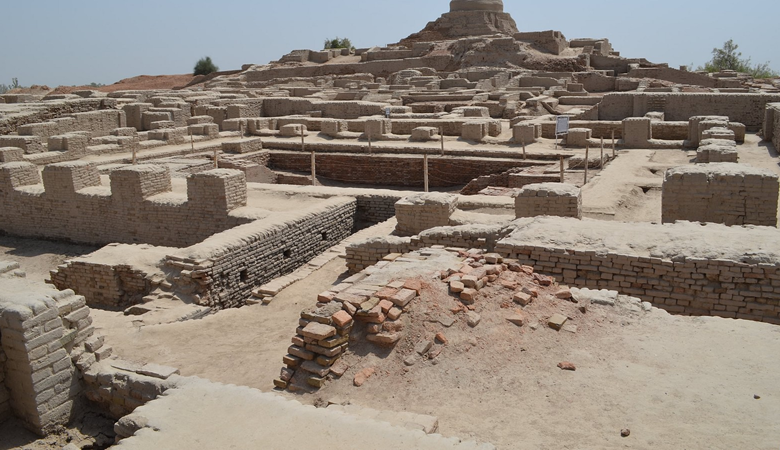Indus-Sarasvati Civilization:
One of the Largest Civilizations of the Ancient World

New Mania Desk / Piyal Chatterjee / 7th March 2025
Approximately 50 million years ago, the enormous tectonic plate recognized as the Indian subcontinent collided with Asia, resulting in the creation of the world’s tallest mountain range, the Himalayas—meaning “the home of snow” in Sanskrit—which divides the Tibetan Plateau from the Indian subcontinent. The Hindu Kush Himalayan (HKH) area spans 3,500 km across all or portions of eight nations, ranging from Afghanistan in the west to Myanmar in the east, influencing air and water circulation systems and altering the climate in the area. Currently, it serves as the origin of ten major Asian river systems—the Amu Darya, Indus, Ganges, Brahmaputra (Yarlung Tsangpo), Irrawaddy, Salween (Nu), Mekong (Lancang), Yangtse (Jinsha), Yellow River (Huanghe), and Tarim (Dayan). By pulling warm air from the south that then cooled and fell as heavy rain, the Himalayas generated the monsoons and a rich region in the Northwest that could be the “land of seven rivers” mentioned in the Vedas.
From 7000 to 5000 BCE, pastoral camps and the earliest agrarian communities established themselves in this rich area. Throughout the millennia, these communities evolved and engaged with others, exchanging skills and technologies like pottery, metallurgy, urban planning, and agriculture. Thus, by 2500 BCE, this area evolved into the most prominent, if not the most significant, civilization of the Ancient era, growing to cover more than one million square kilometers during its advanced (Integration) stage, with a population estimated at five million individuals. Referred to as the Indus-Sarasvati Civilization, its peak persisted for approximately thirteen centuries and thrived in the river basins of the Indus, a key river in Asia, and the Sarasvati or Ghaggar-Hakra River, which formerly coursed through northwest India and eastern Pakistan. Most of the identified sites are found either along these significant rivers and their tributaries or along trade pathways connecting larger urban areas.
For hundreds of years, Iran, Central Asia, and the Indian subcontinent participated in seasonal migration and trade, establishing long-standing links between the people of the Indus-Sarasvati Civilization and areas to their West. They likewise formed connections with Gulf Coast cultures extending all the way to southern Mesopotamia and, through intermediaries like Bahrain’s Dilmun merchants, even further. They sent gold, copper, timber, ivory, and cotton to Mesopotamia and brought in bronze, tin, silver, lapis lazuli, and soapstone. To sustain such a large trade network, they must have had sophisticated abilities in ship construction, navigation, and overland transport. Artifacts from the Indus-Sarasvati Civilization, including seals, beads, and pottery, have been discovered in Mesopotamia, Oman, and Bahrain, showing trade with far-off areas via both land and sea. Beasts of burden and wagons were utilized along with seafaring vessels. Less significant trading posts are located far from the core of their civilization, similar to the one at Shortugai in Afghanistan. The newly identified Jiroft location on the Iranian plateau is situated on this trade route, where archaeologists have uncovered lapis lazuli (originating from Afghanistan or western Baluchistan) and carnelian (probably from the Indus Valley), along with artifacts from various other areas.
Archaeology is rooted in European imperialism, which has historically led to a focus on specific areas like Mesopotamia and Egypt more than others. Researchers like Professor Gregory L. Possehl, who wrote Harappan Civilization, estimate that fewer than two percent of an estimated 2,600 sites have been excavated in India, Pakistan, and Afghanistan, with potentially more yet to be discovered.
It is commonly called the “Harappan” civilization due to Harappa, the initial site that was uncovered.
Research in the Indus-Sarasvati area spans from around 7000 BCE to 300 BCE. Many sites seem to be small towns and villages, yet others, like the site of Ganweriwala in Pakistan’s Cholistan region, are believed to span 80 hectares (197.68 acres). Rakhigarhi, situated west of New Delhi, is considered to surpass 225 hectares (555.987 acres), establishing it as the largest site found so far in India and the second largest in the subcontinent, following Mohenjo-Daro, which encompasses 250 hectares (620 acres) in Pakistan.
Despite facing risks from urban expansion and poor management, there is optimism that major advancements in the knowledge of the Indus-Sarasvati Civilization will emerge soon as modern archaeological methods and DNA studies unveil new sites. Historically, early civilizations have been categorized hierarchically based on the complexity of their script, agriculture, urban development, architecture, and trade practices. By all these criteria, the Indus-Sarasvati Civilization should be considered one of the most advanced. This trading civilization possessed several advanced characteristics such as drainage systems, sewers, and baths. They created a measurement system, which could be the earliest instance of a decimal system. Urban design utilized geometric principles. The weights they utilize in commerce form a geometrical progression with consistent increases in ratios.
Since the Indus script has as yet not been deciphered, there is a lot we don’t know about the structure of society in villages or towns, or across the greater civilization. We don’t know if there was a central government, a ruler or standing army, but indications are that there were not. It may have been a loose confederation of merchant cities; cities that sprang up as a result of unique, favorable environmental conditions that initially led to agricultural surpluses and subsequently to productivity surfeits, trade and specialization.






